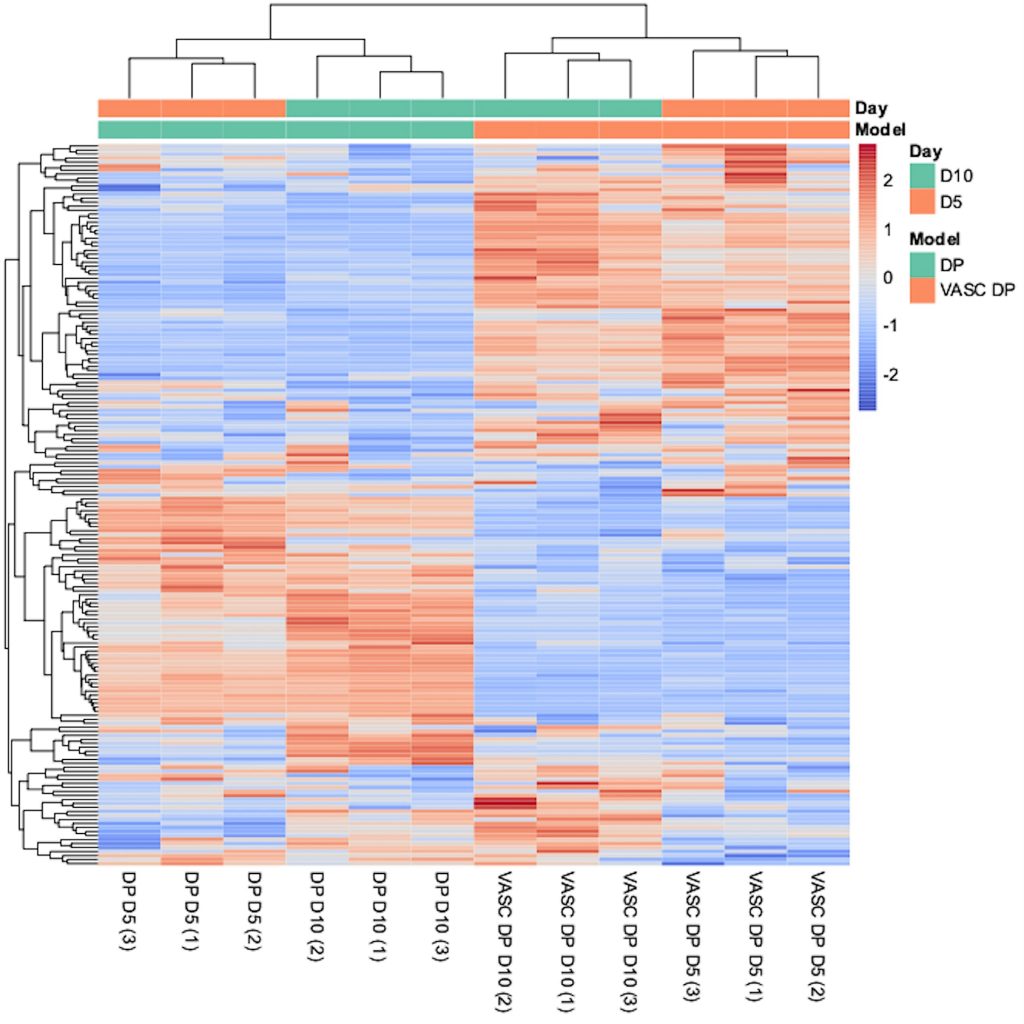The study presents the characterization of advanced 3D in vitro models of human hair follicle dermal papilla (DP), iaming to mimic physiological hair cycle transitions and tissue senescence. Using VitroScreenORA® scaffold-free spheroid platforms, two micro-physiological models were engineering: a standard non-vascularized dermal papilla model (DP) and a more complex vascularized model (VASC-DP), which integrates human dermal microvascular endothelial cells to mirror the capillary loop surrounding the hair follicle bulb.
The study explores two complementary strategies to replicate hair follicle regression: i) a forced involution model, using TGF-β1 and FGF-18 to drive the DP models from anagen to catagen and from catagen to telogen; and ii) a chronological aging model, achieved through extended culture up to 11 days to simulate natural chronological senescence.
In the forced regression paradigm, TGF-β1 induced a downregulation of proliferation-associated genes such as FGF7, while FGF-18 further suppressed CCND1 and WNT5B, confirming telogen phase induction. These transitions mirror physiological checkpoints of the hair cycle and validate the responsiveness of the model to key modulators.

The vascularized model was constructed via co-culture of DP cells with endothelial cells, forming a capillary-like structure confirmed by CD31 expression and 3D imaging. The vascular network was confirmed by the presence of branching and cell polarization, mimicking the in vivo capillary loop. Omics profiling using nanoString nCounter® technology revealed that vascularization significantly influenced the hair follicle gene signature, particularly involving key signaling of WNT pathway, adhesion, migration, and ECM remodeling process.
The aged DP model revealed spontaneous dynamic tissue degeneration after 11 days of culture, characterized by the loss of vascular organization and increased expression of γH2A.X, a key biomarker of DNA damage and cellular senescence. To test the capacity of the model to respond to known hair cycle modulators, treatments with Minoxidil (50 µM), Retinol (10 ng/mL), and Doxorubicin (1 µM) were applied.

Key findings include:
- Minoxidil effectively restored vascular structure and reduced γH2A.X expression, indicating DNA protection. It also promoted alignment of fibronectin fibers, enhancing ECM organization.
- Retinol showed moderate protective effects, partially preserving vascular and stromal architecture and improving FN fiber orientation, though less effectively than Minoxidil.
- Doxorubicin, as expected, caused significant damage, increasing DNA fragmentation and disrupting the endothelial network.
These observations confirm the model’s biological responsiveness and its capacity to replicate both degenerative and regenerative events in hair follicle dynamics.

In conclusions, some pivotal and innovative contributions emerge from this study, highlighting the relevance and potential of the developed model in advancing the understanding of hair follicle biology:
- Development of a physiologically relevant dermal papilla model that integrates vascular architecture, significantly improving biological accuracy over conventional 2D or simplified 3D cultures.
- Capability of the model to simulate key transitions phases of the hair growth cycle, including anagen-catagen-telogen progression, both through induced and spontaneous mechanisms.
- Applications in hair senescence research, investigating key markers of aging (e.g., γH2A.X and FN disorganization) to evaluate anti-aging treatment or hair-regenerative compounds.
- Responsiveness to know bioactive agents, with Minoxidil and Retinol demonstrating therapeutic potiential in reversing or attenuating hair follicle aging features, validating the platform for drug screening and personalized therapy development.
- The innovative integration of a capillary-like structure plays a pivotal role in preserving the functionality of the dermal papilla, a key target compartment for therapeutic success in treating hair loss conditions.
Collectively, these advances establish the DP and VASC-DP spheroid systems as powerful and reliable in vitro systems for investigating molecular mechanisms of hair growth, regression, and aging, while offering a robust preclinical platform for the development of next-generation treatments.

